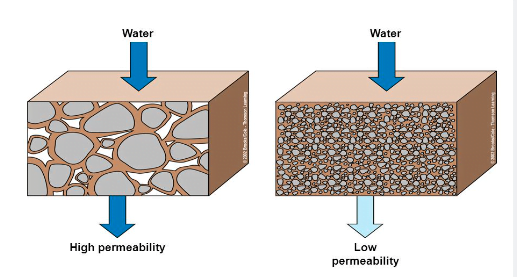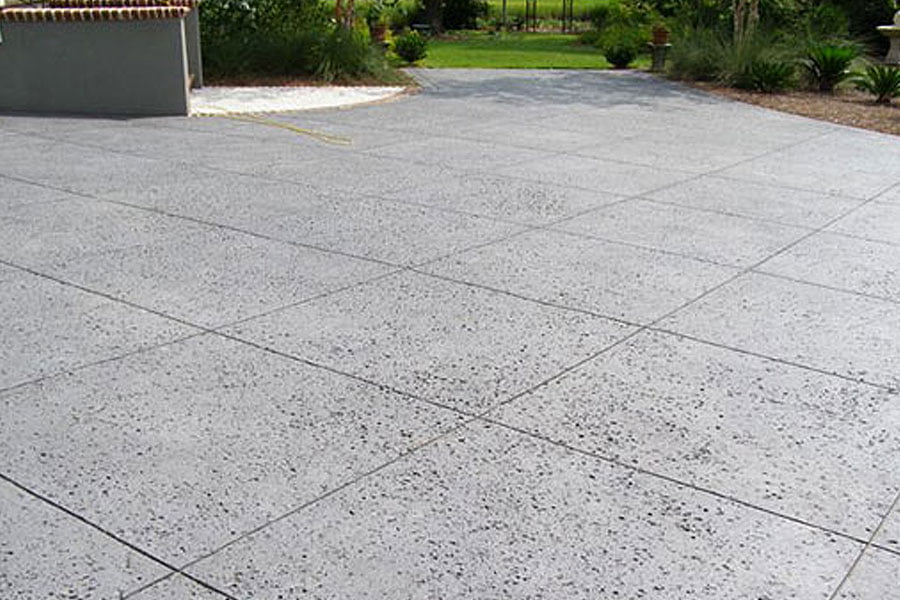Permeability is a property of soil that determines how easily water can move through it. This property is important for many engineering and environmental applications, including water management, foundation design, and waste disposal. The permeability of soil is a function of its texture, structure, and other physical properties.
Definition of Permeability of Soil
Permeability is defined as the rate of flow of fluid (water or air) through a porous material, such as soil, under the influence of a hydraulic gradient. It is commonly expressed in units of velocity (meters per second) or as an equivalent unit of hydraulic conductivity.
To illustrate the concept of soil permeability in a practical context, let’s consider a common scenario in residential landscaping – the installation of a garden. Imagine you’re planning to create a garden in your backyard. You need to ensure that the soil has adequate permeability to support plant growth. If the soil is too permeable, like sandy soil, water drains through it very quickly. This rapid drainage means that water doesn’t stay long enough in the soil for plant roots to absorb it effectively. In such a case, you would find yourself needing to water the garden frequently, and nutrients might also leach away rapidly, making it hard for plants to thrive.
On the other hand, if the soil is not permeable enough, like clayey soil, water tends to remain in the soil for longer durations. While this might sound beneficial, it actually leads to waterlogging. The roots of plants can suffocate because the excess water in the soil pores prevents air from reaching them. This situation can lead to root rot and hinder plant growth.
In this real-world example, the ideal scenario is to have soil with balanced permeability – not too fast, not too slow. This balance ensures that water stays in the soil long enough for the plants to use it, but not so long that it causes waterlogging.
Importance of Permeability of Soil
Permeability is an important characteristic of soil for several reasons. Firstly, it is a major factor in the movement of water in the subsurface, which affects soil stability and the growth of plants. Secondly, it affects the behavior of groundwater systems and the movement of pollutants in the subsurface. Thirdly, permeability is important in the design of foundations, as it affects the rate at which water can be drained from the soil and the stability of the foundation. Finally, permeability is important in the design of waste disposal systems, as it affects the movement of leachate and other pollutants through the subsurface.
Properties of Permeability of Soil
The permeability of soil is determined by several properties, including its texture, structure, and porosity. Soil texture refers to the size and distribution of soil particles, and it affects the amount of space between particles. The structure of the soil is determined by the arrangement of soil particles, and it affects the ease with which water can move through the soil. Porosity is the ratio of the volume of voids to the total volume of the soil, and it affects the amount of water that can be stored in the soil.
Factors Affecting Permeability of Soil
There are several factors that affect the permeability of the soil including,
The permeability of soil is affected by several factors, including:
- Soil particle size
- Soil compaction
- Soil structure
- Soil moisture content
- Soil type
- Presence of organic matter
- Degree of saturation
- Depth of soil layer
- Temperature
- Type and amount of contaminants in soil.
Soil particle size: Soil particle size and distribution influence the size of the pores in the soil and therefore affect permeability. Soils with larger particles and larger pore spaces will be more permeable.
Soil compaction: Compaction, or the degree to which soil is compacted, affects the permeability of soil by reducing the amount of space between soil particles.
Soil structure: Soil structure, such as the formation of clods or soil aggregates, affects permeability by creating channels for water to flow through.
Soil moisture content: Soil permeability increases as soil moisture content increases, as the moisture fills the pore spaces.
Soil type: Different types of soil have different permeabilities. For example, sand is more permeable than clay due to differences in particle size and arrangement.
Presence of organic matter: Organic matter can change the permeability of soil by altering the structure and composition of the soil, and by absorbing water.
Degree of saturation: Soil permeability decreases as soil becomes increasingly saturated. Saturation, or the degree to which soil is filled with water, affects the permeability of soil by reducing the amount of space available for water to move through the soil.
Depth of soil layer: Permeability can vary with depth, as soil properties and structure can change at different depths.
Temperature: Soil permeability can be affected by temperature changes, as the temperature can alter soil structure and moisture content.
Contaminants in soil: The presence of contaminants such as chemicals, salts, or oils can alter the permeability of soil by clogging pores or altering soil structure.
Finally, pressure affects the permeability of soil by changing the hydraulic gradient and the rate of flow of water through the soil.
Darcy’s Law with Assumptions for Permeability
Darcy’s law is a fundamental principle of fluid mechanics that is used to describe the flow of fluid through a porous material, such as soil. The law states that the rate of flow of fluid through a porous material is proportional to the hydraulic gradient, or the difference in fluid pressure, and the permeability of the material.
q = kiA
i = h/L
v =ki
where,
h = hydraulic head
L= Length of the soil specimen
v=velocity of flow
q = discharge
A = total cross-sectional area of soil mass, perpendicular to the direction of flow
i = hydraulic gradient
k = coefficient of permeability
The law is based on several assumptions, including the following:
1. The fluid is incompressible and the flow is steady-state.
2. The fluid is homogeneous and isotropic
3. The flow-through is considered laminar.
4. The fluid follows the path of least resistance through the porous material.
5. The fluid is flowing through a continuous porous medium.
How to Determine Permeability of soil in the field and Laboratory?
There are several methods for determining the permeability of soil in situ, in the field, and laboratory.
In situ or field methods
- pumping tests
- slug tests
- Double Ring Infiltrometer test
- Borehole Permeameter test
Pumping tests
Pumping tests are a commonly used method for determining the permeability of subsurface soils and rocks. They involve pumping water from a well at a constant rate for a specified period of time and measuring the water level in the well and surrounding observation wells. The change in water level over time is used to calculate the permeability of the soil or rock.
There are two main types of pumping tests: constant-rate tests and step-rate tests. Constant-rate tests involve pumping water at a constant rate for a specified period of time. Step-rate tests involve changing the pumping rate during the test to determine the effect of the pumping rate on permeability.
Pumping tests can be conducted in both confined and unconfined aquifers. In confined aquifers, the water level in the observation wells is affected by the permeability of the soil or rock, the permeability of the aquifer, and the properties of the confining layer. In unconfined aquifers, the water level in the observation wells is only affected by the permeability of the soil or rock and the permeability of the aquifer.
Pumping tests can provide valuable information on the permeability of subsurface soils and rocks, but they are limited by several factors, including the size of the test area, the depth of the aquifer, and the pumping rate. The results of pumping tests should be interpreted with caution and should be used in conjunction with other data to obtain a comprehensive understanding of subsurface conditions.
Slug tests
Slug tests are a field method used to determine the permeability of soils. They are used to estimate the hydraulic conductivity, or permeability, of a soil layer by measuring the response of the water table to a sudden change in head. Slug tests are performed by temporarily lowering the water level in a well, and then measuring the time it takes for the water level to return to its original position.
The test involves inserting a small-diameter well into the soil and filling the well with water. The well is then emptied of water, creating a sudden drop in the water level and a change in head. The rate at which the water level returns to its original position is measured and used to calculate the permeability of the soil.
Double Ring Infiltrometer
This method measures the rate at which water infiltrates the soil. A double ring infiltrometer consists of two concentric rings, an outer ring and an inner ring. The soil is compacted between the rings and water is added to the soil surface. The rate at which water infiltrates the soil is then measured over time. This method is useful for determining the permeability of soil in the field and is often used to assess the suitability of soil for irrigation.
Borehole permeameter
This method involves measuring the rate of water flows through a soil sample taken from a borehole. The soil sample is placed in a permeameter and water is added to the top of the sample. The rate of water flow through the sample is then measured over time. This method provides a direct measurement of soil permeability, but is limited by the size of the soil sample that can be collected.
Laboratory methods for determining soil permeability:
Constant head permeameter:
This method involves measuring the flow of water through a soil sample at a constant head. The soil sample is placed in a permeameter and water is added to the top of the sample at a constant head. The rate of water flow through the soil sample is then measured over time. This method provides a direct measurement of soil permeability and is useful for determining the effect of soil structure and composition on permeability.
Falling head permeameter:
This method involves measuring the flow of water through a soil sample under a varying head. The soil sample is placed in a permeameter and water is added to the top of the sample. The head of water is then gradually decreased, and the rate of water flow through the soil sample is measured over time. This method provides information on the relationship between soil permeability and soil moisture content.
Hydraulic conductivity tests:
This method involves determining the relationship between soil moisture content and permeability. Soil samples are compacted to a range of moisture contents and the permeability of each sample is measured. The results are then used to plot the relationship between soil moisture content and permeability, which is known as the hydraulic conductivity curve. This method provides information on the effect of soil moisture content on soil permeability and is useful for understanding the water-holding capacity of the soil.
Permeability is a critical property of soil that affects a wide range of engineering and environmental applications. It is determined by several physical properties of soil, including its texture, structure, and porosity, and is influenced by a number of factors, including soil type, compaction, saturation, temperature, and pressure. Understanding permeability is important for designing and managing water resources, waste disposal systems, and foundation systems. In situ and laboratory methods can be used to determine the permeability of the soil, and Darcy’s law is a commonly used principle for describing fluid flow through porous materials.










One thought on “Permeability of Soil : A Comprehensive Review”